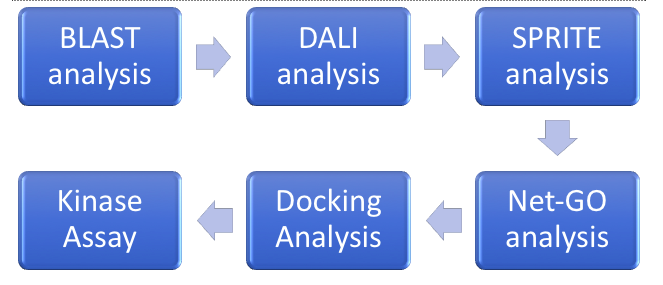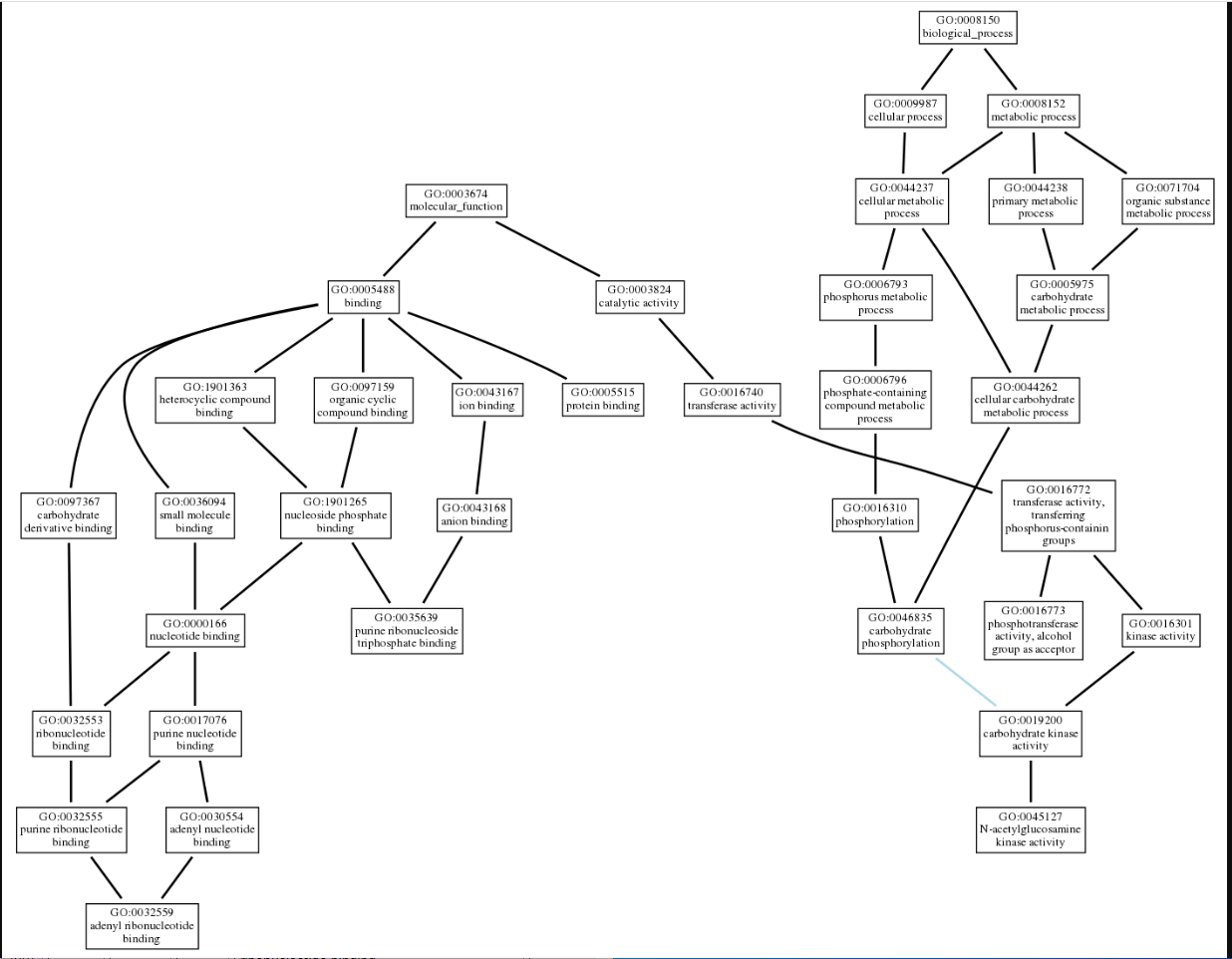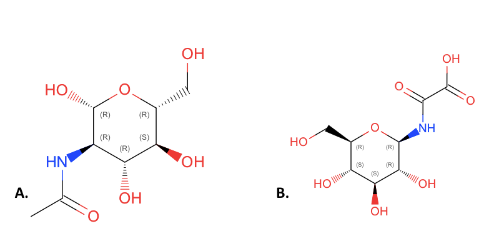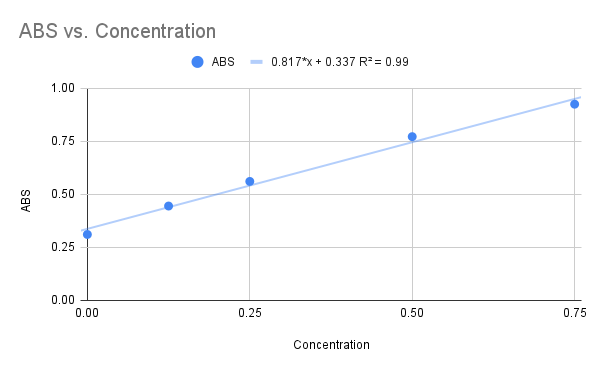BASIL2023GV1ZBS
From Proteopedia
| (9 intermediate revisions not shown.) | |||
| Line 1: | Line 1: | ||
=='''''Inquiry of the Possible Function of Protein 1ZBS'''''== | =='''''Inquiry of the Possible Function of Protein 1ZBS'''''== | ||
==''' Abstract'''== | ==''' Abstract'''== | ||
| - | ZBS is a novel protein whose structure is solved but the function is unknown. This research was designed to attempt to uncover the function. Computational research indicated that N-acetylglucosamine (NAG) may be the potential substrate, and that the protein may phosphorylate NAG. This was determined using multiple computational tools, such as BLAST-P, DALI, SPRITE, InterPro. Molecular docking using NAG as a substrate was done with PyMol and Vina docking. After the computational research was completed, the protein was over-expressed and purified. The protein was used to test for activity with the substrate NAG. The kinase assay concluded that NAG is most likely not the substrate for 1ZBS due to a lack of specific activity. | + | ZBS is a novel protein whose structure is solved but the function is unknown. This research was designed to attempt to uncover the function. Computational research indicated that N-acetylglucosamine (NAG) may be the potential substrate, and that the protein may phosphorylate NAG. This was determined using multiple computational tools, such as BLAST-P, DALI, SPRITE, InterPro. Molecular docking using NAG as a substrate was done with PyMol and Vina docking. After the computational research was completed, the protein was over-expressed and purified. The protein was used to test for activity with the substrate NAG. The kinase assay concluded that NAG is most likely not the substrate for 1ZBS due to a lack of specific activity. |
== '''Introduction''' == | == '''Introduction''' == | ||
<StructureSection load='1zbs' size='340' side='right' caption='1ZBS dimer as in its original state' scene=''> | <StructureSection load='1zbs' size='340' side='right' caption='1ZBS dimer as in its original state' scene=''> | ||
| Line 14: | Line 14: | ||
[[Image:BLASTP.png]] | [[Image:BLASTP.png]] | ||
These results for 1ZBS showed that it was a match to the superfamily BADF. BADF is the superfamily that NAGK proteins also belong in so this was one of the reasons that we believed that 1ZBS may potentially be a NAGK protein. | These results for 1ZBS showed that it was a match to the superfamily BADF. BADF is the superfamily that NAGK proteins also belong in so this was one of the reasons that we believed that 1ZBS may potentially be a NAGK protein. | ||
| + | |||
| + | === InterPro === | ||
| + | InterPro is another sequence alignment software that we used to analyze the protein 1ZBS. This software gave similar results to. the Blast-P analysis, yet again giving matches to the BadF superfamily. The results showed a match to the general superfamily (green), as well as a match to the ATPase domain of the BadF family. These results further supported the idea that our protein should belong to this superfamily. On it's own, this is helpful for a starting place to determine the function but given the rest of the data from the analysis, it helps solidify the potential function of the 1ZBS protein. | ||
| + | [[Image:InterPro_Results_1ZBS.png]] | ||
== '''Structural Alignments''' == | == '''Structural Alignments''' == | ||
=== DALI === | === DALI === | ||
| Line 21: | Line 25: | ||
This is the DALI alignment of 1ZBS and 2CH5, where 1ZBS is colored in green and <scene name='95/957643/2ch5/1'>2CH5</scene> is colored in yellow. The best results from the DALI alignment were mainly proteins with unknown functions, which makes it difficult to deduce a possible function off of. Because of these results, 2CH5, while only matching parts of the sequence was the best result for this analysis as it's function is known. The function of 2CH5 is a NAG kinase, which would further support the thought that 1ZBS could also be a NAG kinase. | This is the DALI alignment of 1ZBS and 2CH5, where 1ZBS is colored in green and <scene name='95/957643/2ch5/1'>2CH5</scene> is colored in yellow. The best results from the DALI alignment were mainly proteins with unknown functions, which makes it difficult to deduce a possible function off of. Because of these results, 2CH5, while only matching parts of the sequence was the best result for this analysis as it's function is known. The function of 2CH5 is a NAG kinase, which would further support the thought that 1ZBS could also be a NAG kinase. | ||
| + | == ''' Additional Tools''' == | ||
| + | === NetGO === | ||
| + | |||
| + | We used NetGo 2.0 to help visualize the potential function of 1ZBS. This software uses predictive modeling to determine potential functions of the protein in query, and produces a set of gene ontology(GO) terms that best aligns with the protein's possible function. It starts with the most general information and builds to become more specific. These results came back in a list form. We then used AmiGo to visualize the connection between the terms. The final results landed us with a protein that has a purine ribonucleotide triphosphate binding domain, and could have some NAG kinase activity. | ||
| + | |||
| + | [[Image: NetGo.png]] | ||
| + | |||
==''' Docking Analysis'''== | ==''' Docking Analysis'''== | ||
| Line 34: | Line 45: | ||
== '''Kinase Assays''' == | == '''Kinase Assays''' == | ||
| - | We used NAG as our final substrate for the 1ZBS kinase assay, but before the kinase assay could be run, a Bradford Assay was needed to determine the concentration of the 1ZBS protein that was over-expressed and purified in the lab. The Bradford Assay gave us the graph below with an R squared value of 0.99, and the equation listed on the graph. | + | We used NAG as our final substrate for the 1ZBS kinase assay, but before the kinase assay could be run, a Bradford Assay was needed to determine the concentration of the 1ZBS protein that was over-expressed and purified in the lab. The Bradford Assay gave us the graph below with an R squared value of 0.99, and the equation listed on the graph. Because this R squared value is fairly close to 1.0, we decided to use this equation to solved for the concentration of the 1ZBS that we over-expressed. |
| + | |||
[[Image:1ZBS_Concentration.png]] | [[Image:1ZBS_Concentration.png]] | ||
| + | After we had run the Bradford Assay, we then ran a kinase assay with 1ZBS and NAG as the substrate. From this assay, we were able to determine that the specific activity was 0.0743 U/mg which is fairly low. | ||
[[Image:1ZBS_CHART.png]] | [[Image:1ZBS_CHART.png]] | ||
== '''Conclusion''' == | == '''Conclusion''' == | ||
| - | We | + | The goal of this research was to determine the function of 1ZBS. We did this by using a series of computational techniques to limit down the possibilities and better focus the research. The first tools allowed us to start general with the superfamily, and grow more specific into similar sequences/structures. The results of the matches lead us to believe that NAG was the substrate for 1ZBS, and docking analysis also showed promise for this hypothesis. |
| - | + | The downfall comes from the results from the kinase assay. This showed that the specific activity of 1ZBS with NAG was only 0.0743 U/mg which is much lower than what is expected from the intended substrate. Because the specific activity was lower than intended, we do not believe that NAG is the correct substrate for 1ZBS, and that 1ZBS is not a N-acetylglucosamine kinase. | |
| - | </StructureSection> | ||
== References == | == References == | ||
| + | <ref>DOI:10.2210/pdb1zbs/pdb </ref> | ||
<references/> | <references/> | ||
Current revision
Inquiry of the Possible Function of Protein 1ZBS
Abstract
ZBS is a novel protein whose structure is solved but the function is unknown. This research was designed to attempt to uncover the function. Computational research indicated that N-acetylglucosamine (NAG) may be the potential substrate, and that the protein may phosphorylate NAG. This was determined using multiple computational tools, such as BLAST-P, DALI, SPRITE, InterPro. Molecular docking using NAG as a substrate was done with PyMol and Vina docking. After the computational research was completed, the protein was over-expressed and purified. The protein was used to test for activity with the substrate NAG. The kinase assay concluded that NAG is most likely not the substrate for 1ZBS due to a lack of specific activity.
Introduction
| |||||||||||
Proteopedia Page Contributors and Editors (what is this?)
Danielle Selover, Carmen Almendarez Rodriguez, Bonnie Hall, Jaime Prilusky








